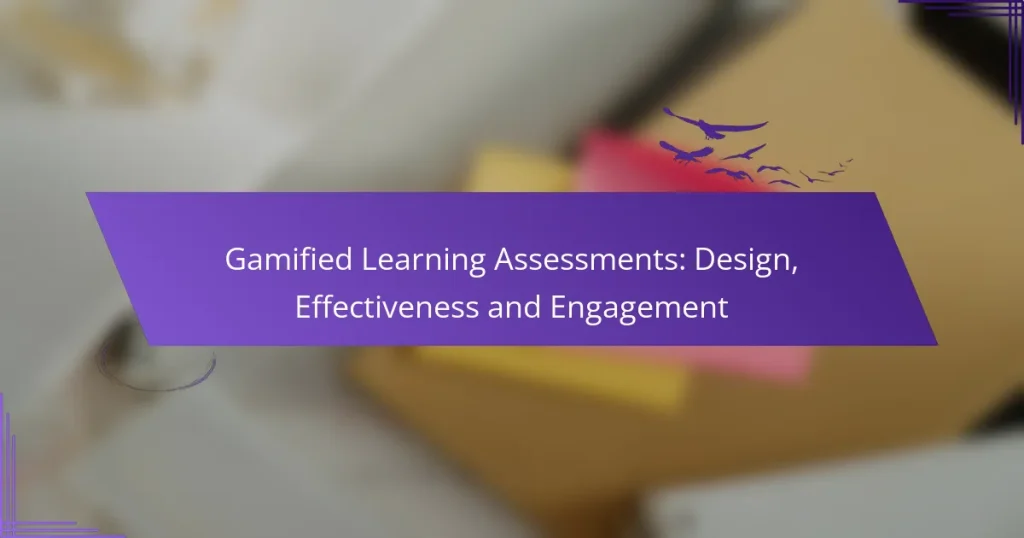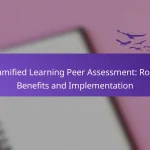Gamified learning assessments leverage game-like elements to enhance engagement and interactivity in online courses, making the educational experience more enjoyable for learners. By focusing on effective design principles, these assessments not only motivate participation but also accurately measure knowledge and skills through clear objectives and balanced challenges. Various tools are available to educators, enabling the creation of interactive quizzes and immersive experiences that foster deeper learning and retention.

How can gamified learning assessments improve engagement in online courses?
Gamified learning assessments can significantly boost engagement in online courses by incorporating game-like elements that make learning more interactive and enjoyable. These assessments motivate learners to participate actively, enhancing their overall educational experience.
Increased motivation through rewards
Gamified assessments often include rewards such as points, badges, or leaderboards that incentivize learners to complete tasks. This system of rewards taps into intrinsic and extrinsic motivation, encouraging students to strive for higher achievements. For example, offering a badge for completing a module can motivate learners to engage more deeply with the content.
To maximize motivation, ensure that rewards are meaningful and aligned with learning objectives. Avoid overwhelming students with too many rewards, as this can dilute their significance and lead to disengagement.
Enhanced retention via interactive elements
Interactive elements like quizzes, simulations, and challenges in gamified assessments enhance retention by making learning experiences more memorable. When learners actively participate in their education, they are more likely to remember the material. For instance, a simulation that allows students to apply concepts in a real-world scenario can reinforce learning effectively.
Incorporate a variety of interactive elements to cater to different learning styles. Balance the complexity of these elements to ensure they remain accessible and do not frustrate learners.
Real-time feedback for learners
Gamified assessments provide real-time feedback, allowing learners to understand their performance immediately and adjust their strategies accordingly. This instant feedback loop helps students identify areas for improvement and reinforces their learning process. For example, a quiz that offers instant explanations for incorrect answers can clarify misconceptions right away.
To enhance the effectiveness of feedback, ensure it is constructive and actionable. Encourage learners to reflect on their performance and set goals for future assessments, fostering a growth mindset.

What are effective design principles for gamified assessments?
Effective design principles for gamified assessments focus on creating engaging experiences that motivate learners while accurately measuring their knowledge and skills. Key elements include clear objectives, storytelling, and a balance between challenge and skill levels.
Clear objectives and goals
Establishing clear objectives and goals is crucial for gamified assessments. These objectives should be specific, measurable, achievable, relevant, and time-bound (SMART) to guide learners effectively. For instance, instead of a vague goal like “improve math skills,” specify “solve 10 algebra problems correctly within 15 minutes.”
When learners understand what is expected of them, they can focus their efforts more effectively. Clear objectives also help in designing the assessment mechanics, ensuring that the game elements align with the educational outcomes.
Incorporation of storytelling elements
Integrating storytelling elements into gamified assessments enhances engagement by providing context and emotional connection. A compelling narrative can transform a standard assessment into an adventure, where learners feel like characters progressing through a storyline. For example, a science quiz could be framed as a mission to save a planet from environmental disaster.
Storytelling not only captures attention but also aids memory retention. When learners relate to a story, they are more likely to remember the information associated with it, making the assessment more effective.
Balanced challenge and skill levels
Maintaining a balance between challenge and skill levels is essential for keeping learners engaged without causing frustration. Assessments should be designed to adapt to varying skill levels, offering different pathways or difficulty settings. This could mean providing hints or alternative questions based on the learner’s performance.
Using a tiered approach can help manage this balance. For example, start with easier questions to build confidence, then gradually increase difficulty. This method encourages learners to push their limits while ensuring that they do not feel overwhelmed.

What tools can be used to create gamified learning assessments?
Several tools are available to create gamified learning assessments, each offering unique features that enhance engagement and effectiveness. These platforms allow educators to design interactive quizzes, competitive games, and immersive experiences that motivate learners and improve retention.
Kahoot! for interactive quizzes
Kahoot! is a popular tool for creating interactive quizzes that can be played in real-time, either in classrooms or remotely. Users can design multiple-choice questions that participants answer using their devices, making learning fun and engaging.
To maximize effectiveness, consider incorporating visuals and varying question types. Kahoot! also allows for leaderboards, which can foster a competitive spirit among participants. Aim for quizzes that take around 10-15 minutes to maintain attention and interest.
Quizizz for competitive learning
Quizizz offers a competitive learning environment where students can complete quizzes at their own pace while competing against their peers. This platform provides instant feedback and allows for customization of quizzes to fit specific learning objectives.
When using Quizizz, leverage its gamification features like power-ups and memes to enhance the experience. Keep quizzes concise, ideally between 10-20 questions, to ensure students stay engaged without feeling overwhelmed.
Classcraft for immersive experiences
Classcraft transforms learning into an immersive experience by integrating role-playing elements into assessments. Students create characters and earn points for completing tasks, which encourages collaboration and engagement.
To implement Classcraft effectively, set clear objectives and align game mechanics with educational goals. Consider using it for longer-term projects or assessments, as the immersive nature can lead to deeper learning and collaboration among students.
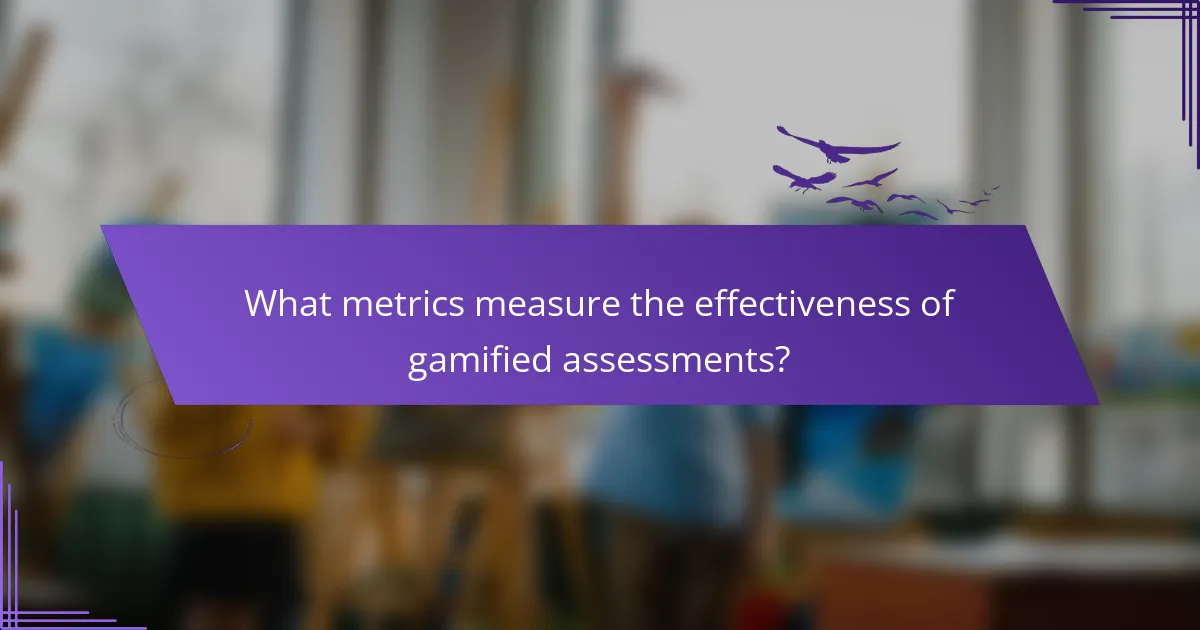
What metrics measure the effectiveness of gamified assessments?
Effectiveness of gamified assessments can be measured through various metrics that reflect engagement, knowledge retention, and student satisfaction. These metrics provide insights into how well gamification enhances the learning experience compared to traditional methods.
Engagement rates and completion times
Engagement rates indicate how actively students participate in gamified assessments, often measured by the percentage of students who start and complete the tasks. High engagement rates typically correlate with lower completion times, suggesting that students are more motivated and focused when learning is gamified.
To assess engagement, educators can track metrics such as time spent on tasks and the frequency of interactions within the gamified platform. For example, a well-designed assessment might see completion times drop to single-digit minutes, indicating a streamlined and engaging experience.
Improvement in knowledge retention
Knowledge retention can be evaluated by comparing pre-assessment and post-assessment scores. Gamified assessments often lead to significant improvements in retention, as the interactive elements reinforce learning through repetition and application of concepts.
To measure this improvement, educators can use quizzes or tests immediately following the gamified experience and again after a set period, such as weeks or months later. A common approach is to aim for retention rates that exceed traditional methods by at least 20-30%.
Student satisfaction surveys
Student satisfaction surveys provide qualitative insights into how learners perceive gamified assessments. These surveys can include questions about the enjoyment of the learning experience, perceived relevance of the content, and overall satisfaction with the gamification elements.
Effective surveys often utilize a Likert scale to quantify responses, allowing educators to identify areas for improvement. Aim for a satisfaction rate of at least 80% to ensure that the gamified approach resonates well with students and enhances their learning experience.
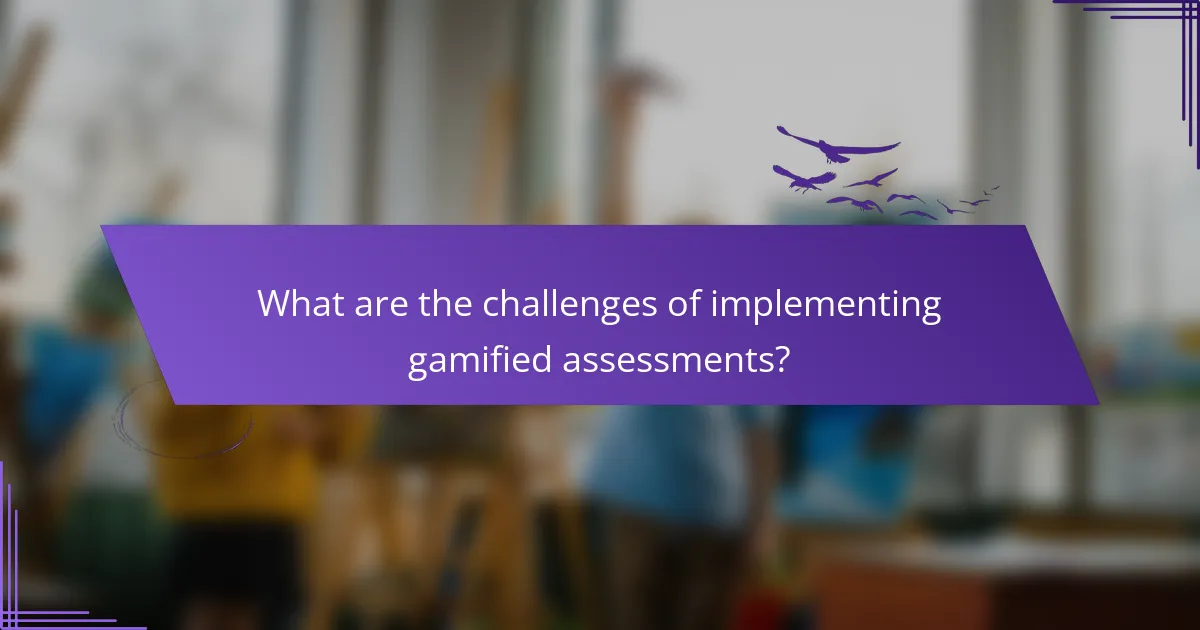
What are the challenges of implementing gamified assessments?
Implementing gamified assessments presents several challenges, including resource allocation, maintaining educational integrity, and addressing technical issues. These factors can significantly impact the effectiveness and engagement levels of the assessments.
Resource allocation for development
Developing gamified assessments requires significant resources, including time, money, and expertise. Organizations must invest in skilled personnel who understand both educational principles and game design to create effective assessments.
Budgeting for gamified assessments can vary widely, often ranging from a few thousand to tens of thousands of dollars, depending on the complexity and scale of the project. It’s crucial to plan for ongoing maintenance and updates to keep the content relevant and engaging.
Balancing fun with educational value
One of the key challenges is ensuring that gamified elements enhance rather than detract from the educational objectives. While engaging gameplay can motivate learners, it must align with learning outcomes to be effective.
To achieve this balance, educators should focus on integrating game mechanics that reinforce key concepts, such as rewards for mastery or challenges that promote critical thinking. Regular feedback from learners can help identify whether the fun elements are supporting or hindering their educational experience.
Technical issues and accessibility
Technical challenges can arise during the implementation of gamified assessments, including software compatibility and user experience issues. Ensuring that the platform works smoothly across various devices is essential for broad accessibility.
Accessibility is particularly important, as assessments should be usable by all learners, including those with disabilities. Adhering to established accessibility standards, such as WCAG, can help ensure that gamified assessments are inclusive and effective for diverse user groups.
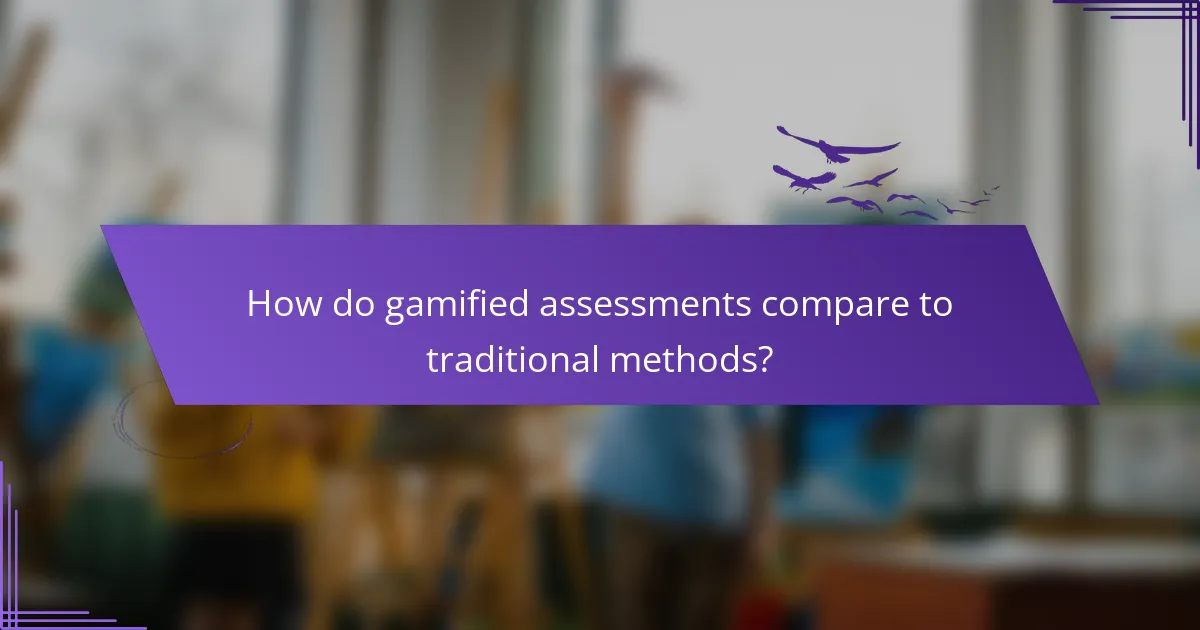
How do gamified assessments compare to traditional methods?
Gamified assessments engage learners more effectively than traditional methods by incorporating game elements that motivate participation and enhance retention. While traditional assessments often rely on rote memorization and standardized testing, gamified approaches create interactive experiences that can lead to deeper learning and improved outcomes.
Higher engagement levels
Gamified assessments significantly boost engagement levels compared to traditional methods. By integrating elements like points, badges, and leaderboards, these assessments create a competitive and enjoyable environment that encourages learners to participate actively. This increased engagement can lead to higher completion rates and better retention of information.
For example, a study might show that learners participating in gamified assessments spend 30-50% more time on tasks than those using conventional methods. This extended interaction allows for more thorough understanding and mastery of the material.
To maximize engagement, consider incorporating feedback loops and social elements, such as team challenges or peer reviews. Avoid overly complex game mechanics that might distract from the learning objectives, and ensure that the game elements align with the educational goals.
